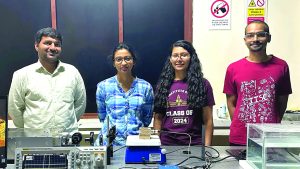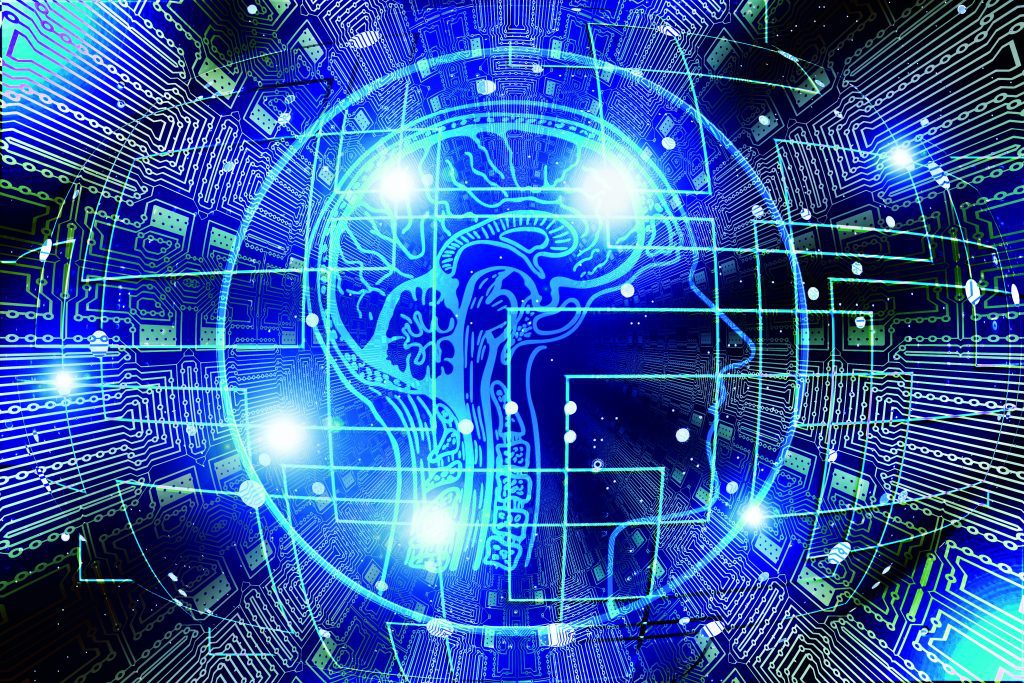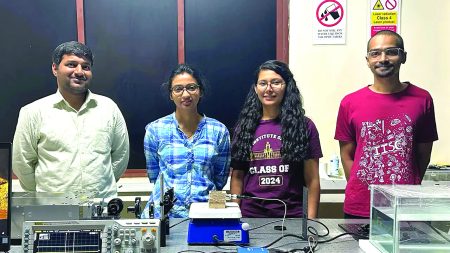Shakti is a young woman who has a successful career in AI and works in the vibrant AI city of Bengaluru. She is not just a data scientist; she is a storyteller, and through this article, she wants to share the aspirations, challenges and suggestions of millions of youngsters of our country, who want to work and make our country a global power in AI.
FROM VEDIC THOUGHT TO VIRTUAL MINDS
Sitting in the heart of Bengaluru’s bustling tech corridors, it’s easy to forget how far we’ve come—and how ancient our curiosity is. Long before silicon chips and neural networks, Indian minds were already contemplating the essence of intelligence.
THE RIGVEDA URGES US:
‘A no bhadra kratavo yantu visvata’ — Let noble thoughts come to us from every side.
Today, Artificial Intelligence (AI) is one such noble thought—arising from every corner of this country, reshaping the way we live, work, and dream.
LOOKING BACK: ANCIENT IDEAS, MODERN ROOTS
India’s fascination with intelligent systems isn’t new. Our epics and scriptures tell tales of ‘Yantra-Manavas’—mechanical beings built by sages and engineers. The concept of mantra-driven machines hinted at cognitive automation long before the term existed.
AI in India, like in much of the world, began in the theoretical spaces of academia. In the 1980s and ’90s, global research hubs such as MIT and Stanford were experimenting with machine vision, rule-based systems, and early neural networks. India, meanwhile, was laying the groundwork in a quieter, more fragmented way.
EARLY INSTITUTIONAL ENGAGEMENT
- Tata Institute of Fundamental Research (TIFR) and Indian Statistical Institute (ISI Kolkata) began exploring statistical learning and logic-based AI.
- IITs and IISc Bangalore contributed to theoretical computer science, pattern recognition, and robotics.
- Government-funded research labs like DRDO and ISRO deployed rudimentary AI in military simulations, speech recognition, and trajectory planning.
AI was a whisper then — discussed in academia, researched in small labs, and largely seen as a futuristic fantasy. But even in that silence, the seeds were planted.
THE PRESENT: INDIA’S AI AWAKENING
Fast-forward to today, India is one of the largest AI talent ecosystems globally. From startups in Hyderabad to research labs in Chennai, we are solving real-world problems using cutting-edge AI.
Flagship initiatives such as:
- INDIAai (the National AI Portal),
- NITI Aayog’s AI for All, and
- Smart India Hackathon
are catalysing both awareness and innovation.
India’s Unique Strengths in AI: Our Strategic Edge
India’s emergence as a global force in AI is not accidental—it is rooted in several core strengths that make us uniquely equipped to drive innovation at scale and with purpose.
1. Vast and Diverse Data Ecosystem
With over 1.4 billion people, India’s data landscape is incredibly rich and diverse. From regional languages and accents to agricultural and health records, this diversity provides a robust foundation for training inclusive and globally applicable AI systems.
2. World-Class Talent Pool
India produces some of the world’s finest engineers and data scientists. Institutions like the IITs, IIITs, and IISc are AI powerhouses, and platforms like NPTEL and AICTE’s MOOCs have democratised AI learning across the country.
3. Thriving Startup Ecosystem
India is home to over 3,000 AI startups working on everything from healthcare diagnostics and conversational bots to precision agriculture and climate forecasting. Bengaluru, Hyderabad, Pune, and Chennai are fast becoming AI innovation hubs.
4. Policy Support and Public Infrastructure
The government’s proactive initiatives such as:
- Digital India
- IndiaStack (including Aadhaar, UPI, and DigiLocker)
- NITI Aayog’s AI Strategy
create a robust digital public infrastructure that facilitates AI deployment at a massive scale.
5. Multilingual and Multicultural Focus
India’s AI efforts include significant investment in language technologies— with models being trained in over 22 scheduled Indian languages. This not only promotes inclusivity but also positions India to serve other multilingual regions across Asia and Africa.
6. Frugal Innovation Culture
India excels in ‘Jugaad’—smart, frugal innovation that solves big problems with limited resources. This mindset is invaluable in developing AI solutions that are cost-effective and scalable for emerging markets.
7. Strong Ethical and Philosophical Foundations
India’s civilisational ethos, rooted in Dharma and Sarvodaya (welfare of all), encourages the development of ethical AI that serves humanity and aligns with the values of fairness, responsibility, and inclusivity.
Our AI is speaking in Bhojpuri, diagnosing TB in rural clinics, helping farmers plan sowing cycles, and assisting courts in streamlining case backlogs. This is not technology for technology’s sake—this is technology for people.
In the same spirit, AI in India must harmonise with our diversity, ethics, and aspirations.


Image Courtesy: Twitter/Mahakumbh
WHY ISN’T INDIA YET A GLOBAL AI POWERHOUSE?
Despite our vast potential and growing momentum, India still faces significant hurdles that prevent it from taking a dominant position in the global AI landscape. Understanding these challenges is essential if we are to truly realise the dream of a Viksit Bharat led by responsible AI.
INDIA’S NATIONAL AI STRATEGY: PROMISING BLUEPRINT, UNEVEN JOURNEY
In 2018, NITI Aayog unveiled India’s first national strategy for artificial intelligence—’#AIforAll’. The document was a bold declaration that India would embrace AI to address social challenges in sectors like:
- Agriculture
- Healthcare
- Education
- Smart cities and infrastructure
- Smart mobility and transportation
It also proposed the creation of a two-tier AI ecosystem:
- Centres of Research Excellence (COREs) for fundamental research, and
- International Centres for Transformational AI (ICTAIs) for applied research in problem-solving.
WHERE IT WORKED
- The strategy succeeded in putting AI on the national agenda. It led to the creation of platforms like INDIAai, and programmes like RAISE 2020 helped create public discourse around AI and its impact.
- Pilot Projects: Successful AI pilots in crop disease prediction, remote diagnostics, and multilingual translation models were implemented, often in partnership with private players.
- Startup Boost: The AI ecosystem for startups flourished post-2018, with numerous ventures tackling problems from facial recognition to smart irrigation.
WHERE IT FELL SHORT
- No Dedicated AI Budget or Legal Mandate: Unlike countries like China or the UK, India never allocated a sustained, centralised budget specifically for AI strategy implementation. Most initiatives were piecemeal, with no unified push or legal framework.
- Institutional Gaps: COREs and ICTAIs were proposed, but their rollout was limited and fragmented. The envisioned institutions lacked long-term funding, coordination, and follow-through.
- Absence of Comprehensive Regulation: There is still no full-fledged legal framework around ethical AI use, data privacy, algorithmic accountability, or surveillance—crucial for public trust.
- Slow Bureaucratic Integration: AI adoption within government departments and PSUs has been slow. Despite pockets of innovation, large-scale systemic integration remains elusive.
DO WE NEED A NEW NATIONAL AI STRATEGY FOR 2047?
Yes—and urgently. As India marches toward Viksit Bharat 2047, a new strategy is not just desirable but essential. The world of AI has changed dramatically since 2018—with foundation models, generative AI, and autonomous systems now at the forefront.
A 2047 STRATEGY SHOULD INCLUDE:
- A National AI Mission with Dedicated Budget: Like the Space or Digital India missions, AI needs long-term financial and institutional commitment.
- Public-AI Infrastructure: Open-source foundational models for Indian languages, datasets for agriculture/health, and compute access must be public goods.
- Talent and Research Incentives: Reverse the brain drain by creating AI fellowships, post-doc schemes, and return researcher programmes tied to Indian institutions.
- AI for Governance: Mainstream AI in public administration, from judicial reforms to environmental management.
- AI Ethics Act: A framework inspired by Indian philosophical values—Dharma, Nyaya, Satya—to regulate responsible AI in ways that resonate culturally.
A strategy for 2047 must not only be built on silicon and servers—but also on the soul of a civilisation that has always balanced progress with principle.


FEW MORE CHALLENGES FOR GROWTH OF AI IN INDIA INCLUDE THE FOLLOWING:
1. Low Investment in R&D
Compared to AI leaders like the US and China, India invests far less in AI research and innovation. Public and private sector R&D funding remains modest, limiting the scale of advanced, foundational AI development within the country.
India’s total AI spending is only a fraction of what global giants invest annually, resulting in dependence on foreign models and technologies.
2. Talent Drain and Brain Exodus
While India produces exceptional AI talent, much of it migrates abroad for better opportunities. Indian-origin AI leaders are shaping innovations at Google, OpenAI, Meta, and Microsoft—but not always within India.
The ecosystem to retain top AI researchers and offer competitive salaries, mentorship, and research freedom is still maturing.
3. Fragmented AI Ecosystem
There is often a disconnect between academia, industry, and government initiatives. Unlike the tightly integrated AI ecosystems in Silicon Valley or Beijing, India’s innovation pipeline is fragmented, with efforts often working in silos.
4. Lack of Core Research and Foundational Models
India is strong in AI application, but weak in AI creation. We consume and fine-tune models developed elsewhere (like GPT, BERT, DALL·E), but lack a strong presence in foundational model development or original algorithm design.
We must transition from being AI adopters to AI inventors.
5. Digital Divide and Unequal Access
While cities like Bengaluru and Hyderabad are buzzing with AI activity, large swathes of rural India still struggle with basic internet access, let alone AI adoption. This digital divide threatens to deepen socioeconomic gaps.
6. Ethical, Legal, and Regulatory Gaps
India is still developing comprehensive AI regulations. Questions around data privacy, algorithmic bias, surveillance, and accountability remain unresolved, potentially slowing both innovation and trust.
India must not just chase AI excellence—it must earn it through clarity, courage, and commitment.
WORK FOR AN INTELLIGENT, INCLUSIVE TOMORROW
By 2030, India’s AI market is expected to cross $16 billion. But the future is not only about growth—it’s about growth with purpose.
Imagine a future where:
- AI tutors teach in every Indian language.
- Rural clinics use AI to support overburdened doctors.
- Climate-resilient crops are managed by precision agriculture tools.
- Transparent and ethical AI systems support governance and justice.
To make this future real, we must build AI to uplift—not displace—human potential.
VIKSIT BHARAT: A VISION REALISED WITH AI
Viksit Bharat—a developed India—is not a distant dream. It is already in motion. And AI is one of its strongest engines. In this awakening, AI is not merely a tool. It is a companion in our journey—towards dignity, development, and discovery.
IN A VIKSIT BHARAT:
- A tribal student in Chhattisgarh learns coding through an AI-enabled teacher.
- A street vendor in Varanasi uses voice-AI to manage inventory.
- A grandmother in Assam receives AI-assisted healthcare at her doorstep.
This is not science fiction. This is our future—rooted in our values, powered by our intellect, and scaled by our innovation.
*The writer has 37 years global experience in IT and is presently Director, AI, Theta Dynamics, Bengaluru.










